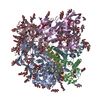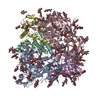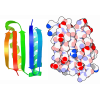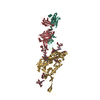[English] 日本語
 Yorodumi
Yorodumi- PDB-6vl5: BG505 SOSIP reconstructed from a designed tetrahedral nanoparticl... -
+ Open data
Open data
- Basic information
Basic information
| Entry | Database: PDB / ID: 6vl5 | ||||||
|---|---|---|---|---|---|---|---|
| Title | BG505 SOSIP reconstructed from a designed tetrahedral nanoparticle, BG505 SOSIP-T33_dn2 | ||||||
 Components Components |
| ||||||
 Keywords Keywords |  DE NOVO PROTEIN / HIV Env / DE NOVO PROTEIN / HIV Env /  de novo / de novo /  nanoparticles / nanoparticles /  vaccine design vaccine design | ||||||
| Biological species | synthetic construct (others) | ||||||
| Method |  ELECTRON MICROSCOPY / ELECTRON MICROSCOPY /  single particle reconstruction / single particle reconstruction /  cryo EM / Resolution: 4.5 Å cryo EM / Resolution: 4.5 Å | ||||||
 Authors Authors | Ward, A.B. / Antanasijevic, A. | ||||||
| Funding support |  United States, 1items United States, 1items
| ||||||
 Citation Citation |  Journal: NPJ Vaccines / Year: 2020 Journal: NPJ Vaccines / Year: 2020Title: Targeting HIV Env immunogens to B cell follicles in nonhuman primates through immune complex or protein nanoparticle formulations. Authors: Jacob T Martin / Christopher A Cottrell / Aleksandar Antanasijevic / Diane G Carnathan / Benjamin J Cossette / Chiamaka A Enemuo / Etse H Gebru / Yury Choe / Federico Viviano / Stephanie ...Authors: Jacob T Martin / Christopher A Cottrell / Aleksandar Antanasijevic / Diane G Carnathan / Benjamin J Cossette / Chiamaka A Enemuo / Etse H Gebru / Yury Choe / Federico Viviano / Stephanie Fischinger / Talar Tokatlian / Kimberly M Cirelli / George Ueda / Jeffrey Copps / Torben Schiffner / Sergey Menis / Galit Alter / William R Schief / Shane Crotty / Neil P King / David Baker / Guido Silvestri / Andrew B Ward / Darrell J Irvine /   Abstract: Following immunization, high-affinity antibody responses develop within germinal centers (GCs), specialized sites within follicles of the lymph node (LN) where B cells proliferate and undergo somatic ...Following immunization, high-affinity antibody responses develop within germinal centers (GCs), specialized sites within follicles of the lymph node (LN) where B cells proliferate and undergo somatic hypermutation. Antigen availability within GCs is important, as B cells must acquire and present antigen to follicular helper T cells to drive this process. However, recombinant protein immunogens such as soluble human immunodeficiency virus (HIV) envelope (Env) trimers do not efficiently accumulate in follicles following traditional immunization. Here, we demonstrate two strategies to concentrate HIV Env immunogens in follicles, via the formation of immune complexes (ICs) or by employing self-assembling protein nanoparticles for multivalent display of Env antigens. Using rhesus macaques, we show that within a few days following immunization, free trimers were present in a diffuse pattern in draining LNs, while trimer ICs and Env nanoparticles accumulated in B cell follicles. Whole LN imaging strikingly revealed that ICs and trimer nanoparticles concentrated in as many as 500 follicles in a single LN within two days after immunization. Imaging of LNs collected seven days postimmunization showed that Env nanoparticles persisted on follicular dendritic cells in the light zone of nascent GCs. These findings suggest that the form of antigen administered in vaccination can dramatically impact localization in lymphoid tissues and provides a new rationale for the enhanced immune responses observed following immunization with ICs or nanoparticles. | ||||||
| History |
|
- Structure visualization
Structure visualization
| Movie |
 Movie viewer Movie viewer |
|---|---|
| Structure viewer | Molecule:  Molmil Molmil Jmol/JSmol Jmol/JSmol |
- Downloads & links
Downloads & links
- Download
Download
| PDBx/mmCIF format |  6vl5.cif.gz 6vl5.cif.gz | 373.4 KB | Display |  PDBx/mmCIF format PDBx/mmCIF format |
|---|---|---|---|---|
| PDB format |  pdb6vl5.ent.gz pdb6vl5.ent.gz | 323 KB | Display |  PDB format PDB format |
| PDBx/mmJSON format |  6vl5.json.gz 6vl5.json.gz | Tree view |  PDBx/mmJSON format PDBx/mmJSON format | |
| Others |  Other downloads Other downloads |
-Validation report
| Arichive directory |  https://data.pdbj.org/pub/pdb/validation_reports/vl/6vl5 https://data.pdbj.org/pub/pdb/validation_reports/vl/6vl5 ftp://data.pdbj.org/pub/pdb/validation_reports/vl/6vl5 ftp://data.pdbj.org/pub/pdb/validation_reports/vl/6vl5 | HTTPS FTP |
|---|
-Related structure data
| Related structure data |  21230MC  6vknC  6vl6C M: map data used to model this data C: citing same article ( |
|---|---|
| Similar structure data |
- Links
Links
- Assembly
Assembly
| Deposited unit | 
|
|---|---|
| 1 |
|
- Components
Components
| #1: Protein | Mass: 56806.613 Da / Num. of mol.: 3 Source method: isolated from a genetically manipulated source Source: (gene. exp.) synthetic construct (others) / Plasmid: pPPI4 / Cell line (production host): 293F / Production host:   Homo sapiens (human) Homo sapiens (human)#2: Protein | Mass: 18971.518 Da / Num. of mol.: 3 Source method: isolated from a genetically manipulated source Source: (gene. exp.) synthetic construct (others) / Plasmid: pPPI4 / Cell line (production host): 293F / Production host:   Homo sapiens (human) Homo sapiens (human)#3: Polysaccharide |  / Mass: 910.823 Da / Num. of mol.: 3 / Mass: 910.823 Da / Num. of mol.: 3Source method: isolated from a genetically manipulated source #4: Polysaccharide | 2-acetamido-2-deoxy-beta-D-glucopyranose-(1-4)-2-acetamido-2-deoxy-beta-D-glucopyranose  / Mass: 424.401 Da / Num. of mol.: 27 / Mass: 424.401 Da / Num. of mol.: 27Source method: isolated from a genetically manipulated source #5: Sugar | ChemComp-NAG /  N-Acetylglucosamine N-AcetylglucosamineHas ligand of interest | N | |
|---|
-Experimental details
-Experiment
| Experiment | Method:  ELECTRON MICROSCOPY ELECTRON MICROSCOPY |
|---|---|
| EM experiment | Aggregation state: PARTICLE / 3D reconstruction method:  single particle reconstruction single particle reconstruction |
- Sample preparation
Sample preparation
| Component | Name: BG505 SOSIP trimer reconstructed from a designed tetrahedral nanoparticle BG505 SOSIP-T33_dn2 Type: COMPLEX Details: BG505 SOSIP trimers were extracted from the T33_dn2 nanoparticles and reconstructed as subparticles. Entity ID: #1-#2 / Source: RECOMBINANT | |||||||||||||||
|---|---|---|---|---|---|---|---|---|---|---|---|---|---|---|---|---|
| Molecular weight | Experimental value: NO | |||||||||||||||
| Source (natural) | Organism: synthetic construct (others) | |||||||||||||||
| Source (recombinant) | Organism:   Homo sapiens (human) / Cell: 293F Homo sapiens (human) / Cell: 293F | |||||||||||||||
| Buffer solution | pH: 7.4 / Details: Freshly prepared buffer, 0.2 uM filtered | |||||||||||||||
| Buffer component |
| |||||||||||||||
| Specimen | Conc.: 4 mg/ml / Embedding applied: NO / Shadowing applied: NO / Staining applied : NO / Vitrification applied : NO / Vitrification applied : YES : YESDetails: BG505 SOSIP-T33_dn2 nanoparticles were prepared by combining equimolar amounts of BG505 SOSIP-T33_dn2A and T33_dn2B components and subsequent incubation. | |||||||||||||||
| Specimen support | Grid material: COPPER / Grid mesh size: 400 divisions/in. / Grid type: Quantifoil R2/1 | |||||||||||||||
Vitrification | Instrument: FEI VITROBOT MARK IV / Cryogen name: ETHANE / Humidity: 100 % / Chamber temperature: 10 K Details: Lauryl maltose neopentyl glycol (LMNG) at a final concentration of 0.005 mM was added to the nanoparticle sample (4.0 mg/mL) and 3 uL was immediately loaded onto plasma-cleaned Quantifoil R ...Details: Lauryl maltose neopentyl glycol (LMNG) at a final concentration of 0.005 mM was added to the nanoparticle sample (4.0 mg/mL) and 3 uL was immediately loaded onto plasma-cleaned Quantifoil R 2/1 holey carbon copper grid (Cu, 400-mesh, Quantifoil Micro Tools GmbH). |
- Electron microscopy imaging
Electron microscopy imaging
| Experimental equipment |  Model: Talos Arctica / Image courtesy: FEI Company |
|---|---|
| Microscopy | Model: FEI TALOS ARCTICA |
| Electron gun | Electron source : :  FIELD EMISSION GUN / Accelerating voltage: 200 kV / Illumination mode: FLOOD BEAM FIELD EMISSION GUN / Accelerating voltage: 200 kV / Illumination mode: FLOOD BEAM |
| Electron lens | Mode: BRIGHT FIELD Bright-field microscopy / Nominal magnification: 36000 X / Nominal defocus max: 2000 nm / Nominal defocus min: 800 nm / Cs Bright-field microscopy / Nominal magnification: 36000 X / Nominal defocus max: 2000 nm / Nominal defocus min: 800 nm / Cs : 2.7 mm / C2 aperture diameter: 70 µm / Alignment procedure: COMA FREE : 2.7 mm / C2 aperture diameter: 70 µm / Alignment procedure: COMA FREE |
| Specimen holder | Cryogen: NITROGEN |
| Image recording | Average exposure time: 11.25 sec. / Electron dose: 50 e/Å2 / Detector mode: COUNTING / Film or detector model: GATAN K2 SUMMIT (4k x 4k) / Num. of grids imaged: 3 / Num. of real images: 2748 |
| Image scans | Movie frames/image: 45 |
- Processing
Processing
| EM software |
| ||||||||||||||||||||||||||||||||||||||||
|---|---|---|---|---|---|---|---|---|---|---|---|---|---|---|---|---|---|---|---|---|---|---|---|---|---|---|---|---|---|---|---|---|---|---|---|---|---|---|---|---|---|
CTF correction | Type: PHASE FLIPPING ONLY | ||||||||||||||||||||||||||||||||||||||||
| Particle selection | Num. of particles selected: 142084 Details: Starting number of BG505 SOSIP-T33_dn2 nanoparticles was 35,521. BG505 SOSIP subparticles were extracted using LocalRec v1.2.0. There are 4 trimeric BG505 SOSIP subparticles per one T33_dn2 ...Details: Starting number of BG505 SOSIP-T33_dn2 nanoparticles was 35,521. BG505 SOSIP subparticles were extracted using LocalRec v1.2.0. There are 4 trimeric BG505 SOSIP subparticles per one T33_dn2 nanoparticle, making a total of 142,084 starting subparticles. | ||||||||||||||||||||||||||||||||||||||||
| Symmetry | Point symmetry : C3 (3 fold cyclic : C3 (3 fold cyclic ) ) | ||||||||||||||||||||||||||||||||||||||||
3D reconstruction | Resolution: 4.5 Å / Resolution method: FSC 0.143 CUT-OFF / Num. of particles: 52939 / Algorithm: BACK PROJECTION / Num. of class averages: 1 / Symmetry type: POINT | ||||||||||||||||||||||||||||||||||||||||
| Atomic model building | Protocol: OTHER / Space: REAL | ||||||||||||||||||||||||||||||||||||||||
| Atomic model building | PDB-ID: 5CEZ |
 Movie
Movie Controller
Controller











 PDBj
PDBj




